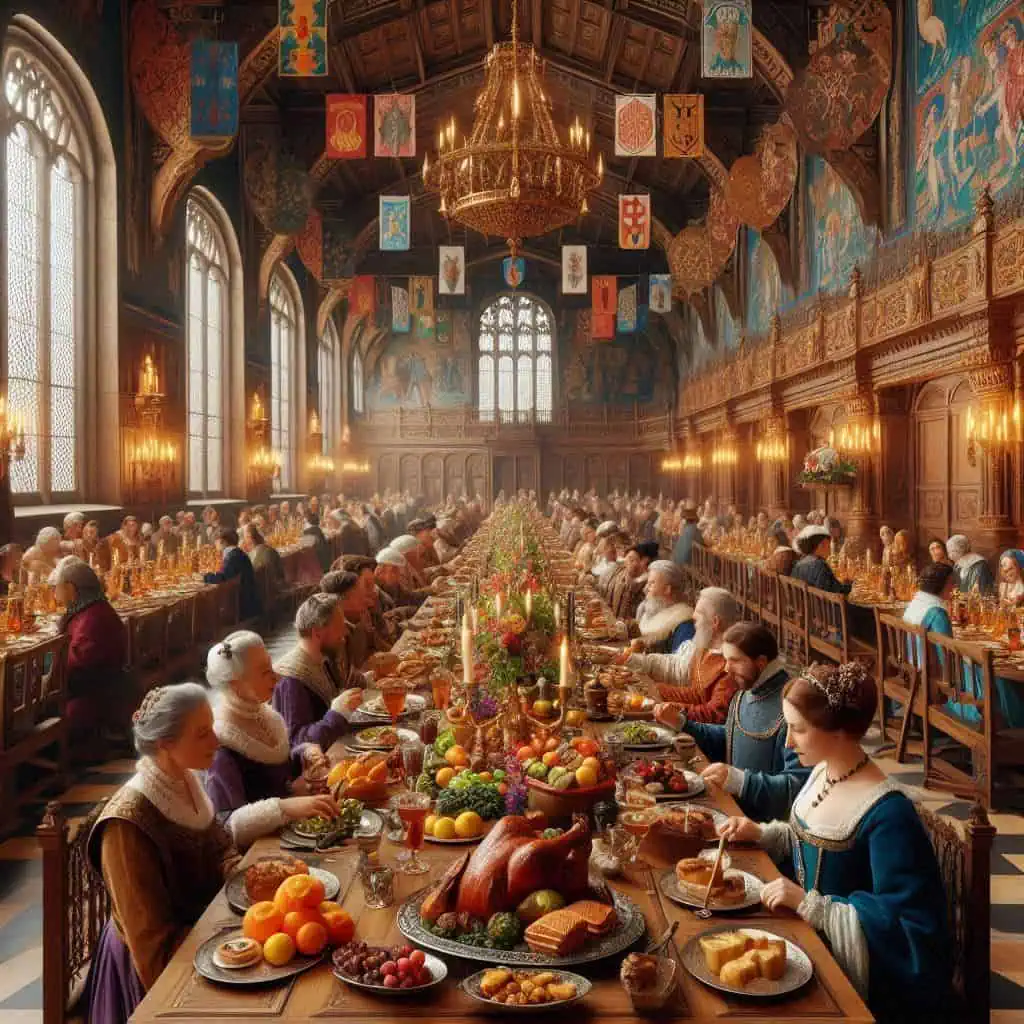When you picture a medieval lord, visions of towering castles, gleaming armor, and grand banquets often come to mind. But life in the Middle Ages wasn’t just about warfare and ruling lands—it was also about displaying wealth, indulging in pleasures, and sometimes outrageous eccentricities. Lords curated their image through fashion, feasts, and peculiar hobbies, blending power, prestige, and vanity.

👗 Lavish Wardrobes That Spoke Volumes
A lord’s clothing was more than fabric—it was a statement of power.
- Silk and velvet: Rare and expensive, showing status.
- Bright colors: Reds, blues, purples—difficult to produce and costly.
- Heavy ornamentation: Gold-threaded tunics, jeweled belts, embroidered coats.
💡 Did you know? Some lords wore clothes weighing over 10 kilograms because of embroidery and jewels!
🍗 Feasts Fit for Kings
Food was theatre and status.
- Multi-course banquets with exotic ingredients: peacock, swan, spiced wine.
- Banquets lasted hours or days, with entertainment like jugglers, minstrels, and falconry displays.
- Lords competed to outshine neighbors, flaunting wealth and generosity.
💡 Did you know? Some feasts displayed gold and silver tableware purely for show, not for eating.

🏹 Eccentric Hobbies and Collections
Lords indulged in quirky interests:
- Hunting: Sport, prestige, and a show of bravery.
- Falconry: Rare birds signaled status.
- Curiosities: Exotic animals, rare coins, or unusual artifacts.
💡 Did you know? Some lords kept lions, leopards, and other exotic animals in private menageries.
🃏 The Folly Factor: Outrageous Displays
Beyond practical extravagance, some lords enjoyed bizarre antics:
- Custom-made armor never used in battle.
- Tournaments with ridiculous rules or fancy costumes.
- Mock battles or theatrical events as entertainment.
💡 Did you know? One lord spent a fortune on a feast served on a boat made entirely of sugar!
🏰 Fashion as Political Strategy
Extravagance was also strategic:
- Clothing and jewels signaled alliances or loyalty.
- Feasts controlled social networks and influenced politics.
- Wealthy displays reminded everyone the lord could fund armies, bribe officials, or host spectacles.
💡 Did you know? Lords commissioned portraits and tapestries in luxurious attire to cement their legacy.

🍷 Rituals of Daily Life
Even mundane routines were opportunities for display:
- Morning prayers in elaborate robes with attendants.
- Meals, even breakfast, were ritualized to impress visitors.
- Daily routines combined utility, spectacle, and subtle power plays.
✨ Conclusion: More Than Just Fancy Clothes
Medieval lords were masters of spectacle, using fashion, feasts, and follies to assert dominance, impress peers, and leave lasting impressions. Every extravagant robe, lavish banquet, and eccentric hobby served a purpose in a world where power was as much about appearance as force.
So the next time you imagine a medieval lord, don’t just picture armor and swords—think of silks, exotic birds, and sugar boats. Their true power often lay in how they dazzled, entertained, and manipulated those around them.
What kinds of clothing did medieval lords wear to display their wealth and status?
Medieval lords wore luxurious fabrics like silk and velvet, often in bright, rare colors. Their garments were heavily embroidered and adorned with jewels and gold thread to showcase their power.
Why were feasts so important in a lord’s life?
Feasts were both social and political tools. They displayed wealth, entertained allies, reinforced loyalty, and sometimes intimidated rivals with extravagant multi-course meals and elaborate presentations.
What unusual hobbies did lords have that set them apart from commoners?
Many lords engaged in hunting, falconry, and collecting exotic animals, coins, or curiosities. These hobbies were status symbols, demonstrating both wealth and sophistication.
How did extravagant displays serve political purposes?
Clothing, jewelry, and lavish feasts could signal alliances, loyalty, or influence. Public displays reminded peers and rivals that a lord had the resources to fund armies, host events, or manipulate social networks.
Were all the luxuries and follies purely for fun?
Not entirely. While some extravagances were for personal enjoyment, most had a strategic function, reinforcing status, impressing allies, and subtly asserting power over rivals.
How did daily routines reinforce a lord’s image of power?
Even mundane activities, like morning prayers or meals, were ritualized and performed with attendants. This careful orchestration demonstrated control, wealth, and social dominance in every aspect of life.



